
Cover Picture
Metal-coordinate complexes (M = 3d, 4f) with enhanced circularly polarized luminescence in planar chiral pillar[5]arenes
Yu Tian, Yijun Lin, Siyu Deng, Yinghe Tan, Xuanyi Bie, Zhaoyang Chen, Pangkuan Chen* Submit a Manuscript
Metal-coordinate complexes (M = 3d, 4f) with enhanced circularly polarized luminescence in planar chiral pillar[5]arenes
Yu Tian, Yijun Lin, Siyu Deng, Yinghe Tan, Xuanyi Bie, Zhaoyang Chen, Pangkuan Chen* Submit a Manuscript
Non-covalent interactions between adsorbed •OH species and UiO-66-NH2 for methane hydroxylation
Yun Zhou, Geqian Fang, Haiyan Wang, Wenjun Yu, Chun Zhu*, Jin-Xia Liang*, Jian Lin*
Chin. J. Struct. Chem., 2025, 44(8), 100629. DOI: 10.1016/j.cjsc.2025.100629
August 1, 2025
Metal–organic frameworks; Density functional theory (DFT); Methane hydroxylation; Hydrogen bond; Spin density
ABSTRACT
UiO-66-H MOFs can effectively catalyze the direct selective oxidation of methane (DSOM) to high value-added oxygenates under mild conditions. However, UiO-66-NH2 with the benzene-1, 4-dicarboxylates (NH2-BDC) ligand modifying the Zr-oxo nodes exhibits relatively inferior catalytic performance for DSOM. Here, a combination of density functional theory (DFT) calculations and experiments was employed to explore the underlying reasons for the limited catalytic activity of UiO-66-NH2. The results indicate that the methane hydroxylation performance of UiO-66-NH2 is almost unaffected by the increase of •OH concentration. This is attributed to the formation of substantial non-covalent hydrogen bonds between the oxygen atoms of the oxygenic species on the Zr-oxo nodes and the hydrogen atoms of -NH2 groups, which diminishes the spin density distribution on the active sites of (•OH)m/UiO-66-NH2, leading to minimal change of the adsorption energy of CH4. Additionally, the calculated adsorption energies (Eads) of CH4 exhibit a linear relationship with the catalytic activity of UiO-66-NH2 for the DSOM reaction.







